|
Brushcutting and tree removal...
Frank Duda, asst supt, Miacomet Golf Club, Nantucket, MA:

"It is really hard to believe that it is almost the middle of December and the weather is still so pleasant. While we all know that this run of good weather must come to an end at some point the maintenance staff has taken this opportunity to accomplish a great deal of work. The tasks we have completed will ultimately land us in a position where we are set to come out of winter and into the spring of 2012 in really good shape.
We have begun the daunting task of tree and brush removal on several of the holes. "Nantucket, Martha’s Vineyard and Tuckernuck are home to 90% of the world’s sandplain grasslands..." |
By removing any woody plants and some trees we hope to encourage the growth of both native plants and grasses. Nantucket, Martha’s Vineyard and Tuckernuck are home to 90% of the world’s sandplain grasslands, and our intent is to keep them as such. The Nantucket Island Land Bank is in charge of maintaining a majority of these sandplain grasslands, which they preserve by either mowing or burning the area yearly. Miacomet follows the same protocol as the Land Bank when it comes to maintaining these areas.
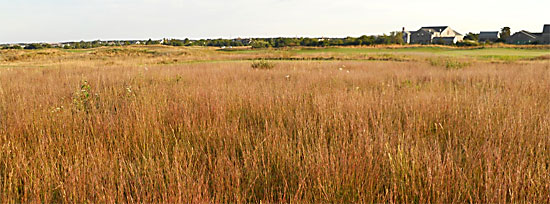
Little Bluestem #6 Tee
If an area is left undisturbed some of the woody plants that begin to appear are considered invasive species by the state of Massachusetts. In particular, Japanese Black Pine Trees are very aggressive growers and dominate once vast sandplain grasslands if given the opportunity. By removing invasive species we are allowing areas to return to a healthy balance of native species.
One particular area on the golf course where you could see the transformation of a sandplain grassland into a woodland was between five and six, where in addition to Japanese Black Pine Trees, Eastern Red Cedar Trees, Scrub Oak and Northern Bayberry started to dominate the area. Once we removed all the trees and woody vegetation we noticed that there is a healthy amount of native grasses that were in the area. By removing the trees and woody plants the area should return to a sandplain grassland over the course of the next couple of years. One area where a grassland restoration was successful is around 6 tees. This area used to be dominated by woody plants. Over the course of several years, and multiple burns and mows the area is currently dominated by native grass species.
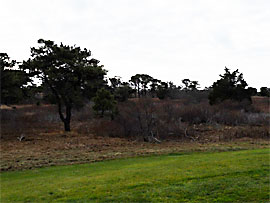 Behind #3 green before...
Behind #3 green before...
|
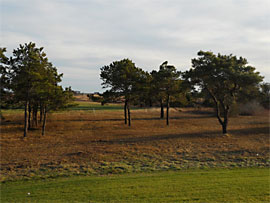
After.
|
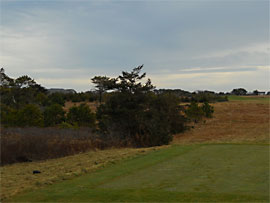
View from #5 Gold tee, before...
|
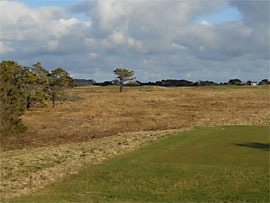
After.
|
Our hope is that over the course of several years we can restore once vast sandplain grasslands into thriving grasslands again. We will also continue to mow and burn the grasslands we have to ensure their continued presence on the golf course. In addition to the ecological benefits of these activities many golfers will notice the enhanced views of both the golf course and the island. So far we have removed brush and trees on holes 2, 3, 4, 5, 6, and 9. We will continue to remove trees and brush throughout the winter on selected areas."
Visit the Miacomet blog at miacometmaintenance.blogspot.com.
|
 |
|
Out with the old and in with the new...
Jim Alwine, Stockton Golf & Country Club, Stockton, CA:
 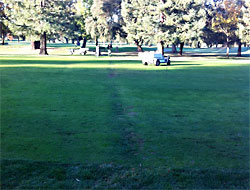
Some projects remain on the to-do list for years before we get a chance to get 'er done. The 16th fairway has a sunken drain line that has been a problem for golfers, mowers, and my to-do list for a solid six years. The depression crosses the fairway at the 250 yd marker, a good spot to conclude a fantastic drive. This low spot is the location of an old concrete drain line that is slowly deteriorating. We patched small portions over the last few years and topdressed to improve lies, but it kept caving in. The bigger problem was the area this pipe used to drain would flood during rain events.
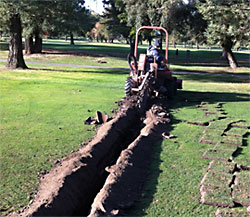 Eventually, we will replace the entire pipe from 15 tee to the left rough of #6. We started with the fairway during our first closed Monday in a number of months. I like our members, but I love closed Mondays. Eventually, we will replace the entire pipe from 15 tee to the left rough of #6. We started with the fairway during our first closed Monday in a number of months. I like our members, but I love closed Mondays.
With five staff members, we sodcut a clearing, trenched out the old pipe, leveled and graded, installed new gravel and pipe, backfilled, and got our sod back down in about 6 hours. This was quick work for a 130 foot stretch of 10 inch concrete drain converted to 6 inch PVC perforated pipe. The trencher made quick work of the brittle concrete and we had the whole line ready for hand cleaning in 25 minutes.
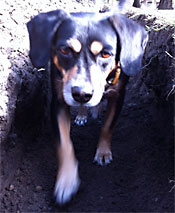 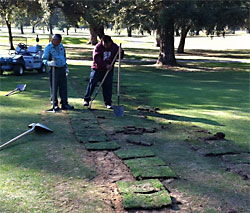 Before we installed the pea gravel and pipe, we sent in our specially trained dog to check for the proper grading. Actually, she was looking for white grubs. She loves those things. Before we installed the pea gravel and pipe, we sent in our specially trained dog to check for the proper grading. Actually, she was looking for white grubs. She loves those things.
Once our pipe was in the ground and backfilled, Dante and Manuel put the sod puzzle back together. This portion of fairway is going to being smooth and uniform so your 250 yard drive will not end up in ground under repair. The drain line is now operational and will be for years to come. And six years after I wrote it down, there is an empty slot on our to-do list.
Visit Jim's blog at sgccturf.blogspot.com/
|
 |
|
Bird Houses???
Joel Kachmarek, Tacoma Country and Golf Club, Lakewood, WA:
 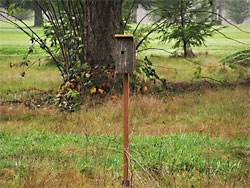
"You might have noticed that all of a sudden we have bird houses in the native area between 11 and 16. This is not an attempt to attract birds although they are real bird houses and I suppose we might get birds taking up residence. In fact these bird houses are simply markers. The native areas on the course were once maintained areas and therefore have irrigation installed in them. The bird houses mark where we have isolation valves and sprinkler heads.
No matter how often we try and locate and trim around these boxes, we always have trouble finding them in the long grass. With the bird houses, it will be easy to quickly locate a valve which is really handy when a sprinkler head needs repair. This next picture shows a bird house near the 18th tee.
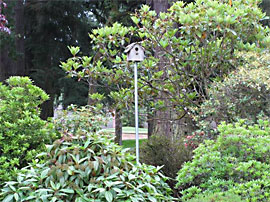 This photo is not a real birdhouse...
This photo is not a real birdhouse...
|
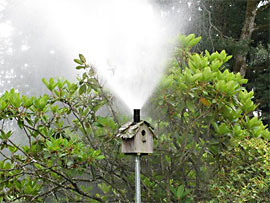 It is actually a sprinkler head on a riser that is disguised as a birdhouse.
It is actually a sprinkler head on a riser that is disguised as a birdhouse.
|
This was designed so the water stream would get over the surrounding shrubs which are getting taller and taller. The post for the birdhouse is actually the pipe feeding the sprinkler head. As the shrubs get taller, it's quite simple to just change out the pipe to a longer one if more height is needed.
Visit Joel's blog at www.tacomaturf.com.
|
 |
|
A great staff...
Steve Cook, CGCS, Oakland Hills Country Club, Bloomfield Hills, MI:
 "2011 was the most difficult year to grow fine turf grass since 1995 and perhaps 1988 too, although 1988 was pretty tough.
 Not only do we have a skilled, talented and hard working staff... more importantly we have a crew made up of good people. Kind and respectful to one another, giving, caring and engaged every day to do what is right. Not only do we have a skilled, talented and hard working staff... more importantly we have a crew made up of good people. Kind and respectful to one another, giving, caring and engaged every day to do what is right.
And it is very fulfilling to hear the crew say that of one another. I have heard repeatedly over the years a staff member speaking highly of the team we have assembled. It is very rewarding to know that the staff respects their coworkers.
So as the sun falls on 2011, I would like to thank my teammates for a spectacular year and for making it a joy to come to work each day!
Visit Steve's blog at ohccturf.blogspot.com
|
 |
|
About our Blog Aggregator: Many superintendents are now hosting private blogs to better communicate with their golfers and/or members. Beyond local weather and course conditions, there is a great deal of information about projects, methodologies and techniques that would be of value to other superintendents — hence our Turf Blog Aggregator. As every blogger struggles occasionally with content, we also include posts intended to educate golfers about turf maintenance for others to use as a template for their own blogs.
|
|